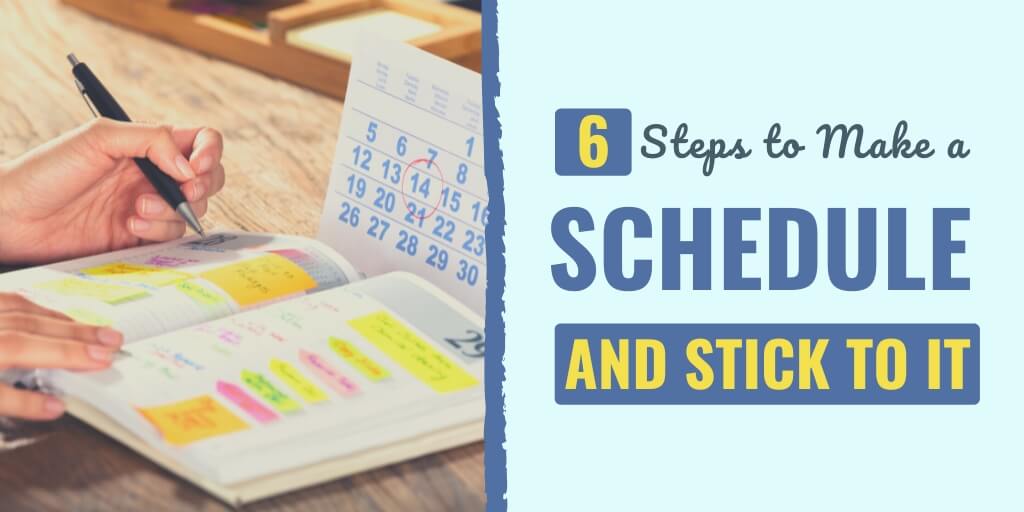There might be affiliate links on this page, which means we get a small commission of anything you buy. As an Amazon Associate we earn from qualifying purchases. Please do your own research before making any online purchase.
You know those moments when you glance at the clock and are instantly jolted into reality as you exclaim, “How is it 3:00 already?!”
You’ve been busy getting things done, but the fact that you only have two more hours to wrap things up before going home to tend to your family or switching gears to do whatever evening activity you have planned seems a bit unreasonable. Where did the time go?
On days that my calendar is relatively empty, I often find myself waking up thinking about all the things that I will be able to accomplish that day since I have minimal obligations. However, my best intentions aren’t so effective if I can’t follow through with them.
Often, once I have finished just one project, the day is more than halfway over and I’m left wondering how I spent so much time on something that shouldn’t have taken so long.
This recurring incident made me realize that if I don’t have a daily plan, it is easy to become disorganized and waste time trying to get back on track.
Having a schedule allows you to realize your potential when it comes to productivity because you become relieved from tempting distractions. This ultimately reduces the pressure of rushing through things in order to get everything you need finished on time.
In this article, I will show you how to stick to a schedule using 6 steps that I’ve found to be extremely helpful at making my intentions become reality.
Once you create daily habits and routines that reinforce your productivity, you will feel more in control of your life and never want to go back to ”winging it” with your daily schedule.
6 Steps to Stick to a Schedule
#1. Start from the beginning.
Whether you have been living with no schedule at all or you usually attempt to make a schedule but rarely stick to it, there are a few things to keep in mind to ensure you will be successful in creating and sticking to your plans.
First, like most things, the hardest part about sticking to a schedule is getting started and becoming used to that sense of commitment. Give yourself some motivation to start this new method of being productive by choosing some things that you would be excited about changing.
For example, would it make you happy to be able to move the pieces of your schedule’s puzzle in a way that ensures you’re always able to attend that 5:30 Zumba class? If you can be sure to plan things into your day that you truly enjoy, you will be motivated to stick to your calendar.
Second, remember that it takes anywhere from 3 weeks to 66 days to form a new habit. (Watch the video below to learn how long it takes to build a habit.)
This means that once you start making your schedule, you have to give yourself time to adjust to sticking to it so you can be sure that you’re allowing yourself a fair chance to succeed.
This time will also allow you to make any necessary tweaks to your schedule to make it easy for you to stick to. Don’t get frustrated if the first schedule that you make doesn’t work out. Your daily schedule is meant to benefit you and only you, so go ahead and tweak away.
Finally, staying organized with a good planner that helps you manage your time will be a powerful tool. Whether this is a physical journal, an online app, or a wall calendar, you have to find what works best for you. Which brings me to my next point…
#2. Keep everything on your agenda in one place.
Too often, people carry a day planner, have a giant monthly planning calendar on their wall, have an online calendar, and have a family calendar on a whiteboard in their kitchen.
The problem with this is that you’re increasing your chances of making a mistake of double booking yourself or not allowing yourself enough time between activities.
To avoid forgetting about commitments entirely, stick to one place where you record all of your plans and obligations. This will prevent you from having to switch back and forth from one calendar to another, which will increase your chances of accomplishing everything without becoming overwhelmed.
Because you can only be in one place at one time, it makes sense to be able to see all of your commitments at a glance in just one place.
Staying organized in this way will allow you to have the ability to see if or where you can fit in additional tasks that come your way and be able to anticipate any potential scheduling conflicts before they come up.
#3. Block out times for your obligations that cannot be changed.
Set aside the necessary time in your schedule for your meetings, appointments, etc. that are set into stone.
These events on your calendar can’t be pushed aside by any “more pressing” issues that often distract us from our daily routine, such as scrolling through social media, doing laundry, sorting through emails, and other things that can end up taking a lot more time than they needed to.
When you’re blocking off time for scheduled events, don’t forget to take any travel time into consideration and the time you will need to get prepared for the meeting. Also, leave yourself some buffer time after the appointment to be able to get back to your “home base” of work, get resituated, and get refocused.
The point here is to plan in some wiggle room for things to run late or unexpected obstacles to come up so these blocks of time don’t end up running into your next scheduled activity.
#4. Focus on one thing at a time.
Do you have a tendency to take a peek at Facebook while you're in the middle of completing a task?
Or do you find yourself wandering over to your co-worker’s desk to see what they’re up to if you feel like your brain needs a break?
We will talk about scheduling in your breaks later, but for now, let’s talk about the importance of giving each task on your schedule your complete attention.
The reason you make a schedule in the first place is to prevent everything from happening at once. The ability to “multitask” is a buzzword in business that people often consider to be a strength. However, multitasking decreases your productivity, and the reasons behind this are pretty obvious.

If half of your mind is on one task, a quarter of your mind is focused on something else, and the other quarter is paying attention to something else, nothing is getting done to the best of your ability and you’re more than likely going to make a few mistakes.
Think about it, if people were meant to multitask, texting and driving would not be a big deal.
You may think that you are getting more things accomplished when you’re attempting to multitask, but at what cost? Studies have shown that if you switch back and forth from one project to another, it can decrease your productivity by up to 40%.
Rather than trying to do more than one thing at a time, identify what your priorities are, and work on them individually, giving your entire focus to each task as you go along.
Being skilled in time management isn’t about getting more things done at once, it is about successfully accomplishing more of the important things.
#5. Schedule in your breaks.
Yes, you need to give your brain a rest between times in which you are entirely focused on the task at hand.
One way to schedule in breaks is to follow the Pomodoro Technique, in which you spend 25 minutes fully focused on the task at hand and then take a 5 minute break.
This means that when those 25 minutes are in effect, you ignore any email notifications, you forget about social media, you silence your text messages, and you avoid doing anything else that is potentially distracting. You stay in your zone and remain completely focused.
For example, let’s say you are working on a long written report for work. Put aside any distractions, silence your phone, make yourself physically comfortable, and set a timer for 25 minutes.
Until your timer goes off, remain deeply engaged with your work without thinking about other things on your to-do list or your afternoon plans. Knowing that you have a break in sight will help you commit to this system.
When you are using this technique (or any other scheduling technique) you have to remember that your breaks are a mandatory part of your schedule. Your brain needs some quiet time to rejuvenate and prepare for your next period of working time.
During your short breaks, run to the bathroom, get something to eat or drink, stretch a little bit, or go for a quick walk. After doing a few sets of this work/break routine, then you can take a longer break to work out, get on social media, or do whatever you want to do with your time.

#6. Be realistic when creating your schedule.
You know yourself better than anyone else, so it is good to be able to recognize that another person’s schedule might not necessarily work for you. Your personal values and priorities are going to influence your everyday activities.
For example, if one of your priorities and tools that you use to be your best self is meditation, that will be something that you prioritize in your daily schedule and possibly set aside several short periods of time during your day to focus on your breathing and do some reflection.
On the other hand, your co-worker may book back-to-back appointments all day so he or she can rush out the door in time to get to the gym.
The point here is that just because someone with your same job title plans their day to be able to leave the office by 4:00, it doesn’t mean that this would be an ideal strategy or system for you.
Be realistic in your wants and needs when creating your agenda and make sure that your schedule will not require you to compromise your personal values or priorities.

Finally, your schedule should be considered to be an ideal plan–but it is certainly not set in stone. You can make changes to it as your week progresses and if you miss something that you had planned on doing, you can’t beat yourself up over it.
If you're a solopreneur or a freelancer who can decide your own schedule, you may want to learn more about the 9/80 works schedule and see if it works for you.
Final Thoughts on How to Stick to a Schedule
It can take some time to develop a schedule that works for you to the point that you’re able to stick to it and therefore be as productive as possible. Just keep making small changes until you find what works best for you.
Don’t stop trying to stick to a schedule if it doesn’t work right away. Any type of change to your normal routine will require some time for adjustment.
The secret to success here is knowing that your schedule is realistic, and being able to stick to it until it becomes second nature and you don’t have to think about it too much.
If you have one bad day where you weren’t able to follow through with even one thing on your schedule, it’s alright–just try again the next day. Remember that every new day is the start of a new (and possibly fantastic) beginning, so give yourself time to perfect your scheduling abilities.
Next time you’re trying to create a schedule, come back to this list to review some of these techniques for successful schedule creation and strategies to ensure that you’re sticking to your plans.
And remember, your daily routine does not need to be carried out exactly word for word as you plan it because everyone has unexpected obstacles and barriers to face that you will need to work around.
And if you're looking for more resources to help you stick to you goals, check out these blog posts:
- How to Plan Your Week: 7 Steps to Focus on What’s Important
- 11 Printable Monthly Goals Templates & Worksheets
- How to Create a Ten Year Plan for Your Life [with a Template]
Finally, if you want to level up your productivity and time management skills, then watch this free video about the 9 productivity habits you can build at work.

Connie Mathers is a professional editor and freelance writer. She holds a Bachelor's Degree in Marketing and a Master’s Degree in Social Work. When she is not writing, Connie is either spending time with her daughter and two dogs, running, or working at her full-time job as a social worker in Richmond, VA.


